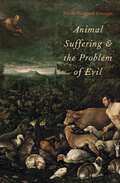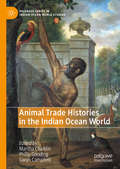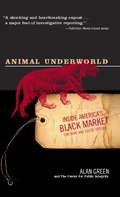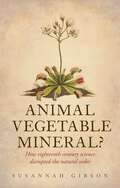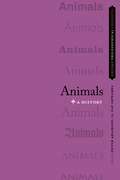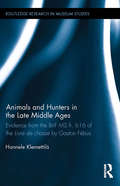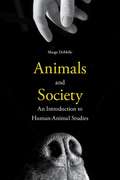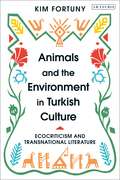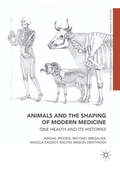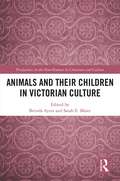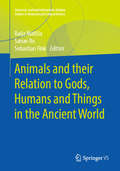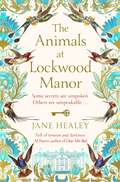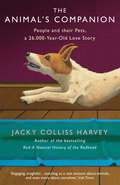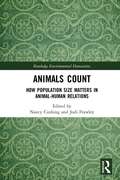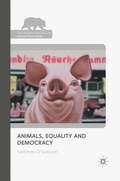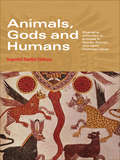- Table View
- List View
Animal Suffering and the Problem of Evil
by Nicola Hoggard CreeganNicola Hoggard Creegan offers a compelling examination of the problem of evil in the context of animal suffering, disease, and extinction and the violence of the evolutionary process. Using the parable of the wheat and the tares as a hermeneutical lens for understanding the tragedy and beauty of evolutionary history, she shows how evolutionary theory has deconstructed the primary theodicy of historic Christianity-the Adamic fall-while scientific research on animals has increased appreciation of animal sentience and capacity for suffering. Animal Suffering and the Problem of Evil responds to this new theodic challenge. Hoggard Creegan argues that nature can be understood as an interrelated mix of the perfect and the corrupted: the wheat and the tares. At times the good is glimpsed, but never easily or unequivocally. She then argues that humans are not to blame for all evil because so much evil preceded human becoming. Finally, she demonstrates that faith requires a confidence in the visibility of the work of God in nature, regardless of how infinitely subtle and almost hidden it is, affirming that there are ways of perceiving the evolutionary process beyond that "nature is red in tooth and claw."
Animal Trade Histories in the Indian Ocean World (Palgrave Series in Indian Ocean World Studies)
by Martha Chaiklin Gwyn Campbell Philip GoodingThis book examines trades in animals and animal products in the history of the Indian Ocean World (IOW). An international array of established and emerging scholars investigate how the roles of equines, ungulates, sub-ungulates, mollusks, and avians expand our understandings of commerce, human societies, and world systems. Focusing primarily on the period 1500-1900, they explore how animals and their products shaped the relationships between populations in the IOW and Europeans arriving by maritime routes. By elucidating this fundamental yet under-explored aspect of encounters and exchanges in the IOW, these interdisciplinary essays further our understanding of the region, the environment, and the material, political and economic history of the world.
Animal Underworld: Inside America's Black Market for Rare and Exotic Species
by Alan GreenA vast and previously undisclosed underground economy exists in the United States. The products bought and sold: animals. In Animal Underworld, veteran investigative journalist Alan Green exposes the sleazy, sometimes illegal web of those who trade in rare and exotic creatures. Green and The Center for Public Integrity reveal which American zoos and amusement parks dump their "surplus" animals on the middlemen adept at secretly redirecting them into the private pet trade. We're taken to exotic-animal auctions, where the anonymous high bidders are often notorious dealers, hunting-ranch proprietors, and profit-minded charlatans masquerading as conservationists. We visit some of the nation's most prestigious universities and research laboratories, whose diseased monkeys are "laundered" through this same network of breeders and dealers until they finally reach the homes of unsuspecting pet owners. And we meet the men and women who make their living by skirting through loopholes in the law, or by ignoring the law altogether. For anyone who cares about animals; for pet owners, zoo-goers, wildlife conservationists, and animal welfare advocates, Animal Underworld is gripping, shocking reading.
Animal Underworld: Inside America's Black Market for Rare and Exotic Species
by Alan GreenA vast and previously undisclosed underground economy exists in the United States. The products bought and sold: animals. In Animal Underworld, veteran investigative journalist Alan Green exposes the sleazy, sometimes illegal web of those who trade in rare and exotic creatures. Green and The Center for Public Integrity reveal which American zoos and amusement parks dump their "surplus" animals on the middlemen adept at secretly redirecting them into the private pet trade. We're taken to exotic-animal auctions, where the anonymous high bidders are often notorious dealers, hunting-ranch proprietors, and profit-minded charlatans masquerading as conservationists. We visit some of the nation's most prestigious universities and research laboratories, whose diseased monkeys are "laundered" through this same network of breeders and dealers until they finally reach the homes of unsuspecting pet owners. And we meet the men and women who make their living by skirting through loopholes in the law, or by ignoring the law altogether. For anyone who cares about animals; for pet owners, zoo-goers, wildlife conservationists, and animal welfare advocates, Animal Underworld is gripping, shocking reading.
Animal, Vegetable, Mineral?: How eighteenth-century science disrupted the natural order
by Susannah GibsonSince the time of Aristotle, there had been a clear divide between the three kingdoms of animal, vegetable, and mineral. But by the eighteenth century, biological experiments, and the wide range of new creatures coming to Europe from across the world, challenged these neat divisions. Abraham Trembley found that freshwater polyps grew into complete individuals when cut. This shocking discovery raised deep questions: was it a plant or an animal? And this was not the only conundrum. What of coral? Was it a rock or a living form? Did plants have sexes, like animals? The boundaries appeared to blur. And what did all this say about the nature of life itself? Were animals and plants soul-less, mechanical forms, as Descartes suggested? The debates raging across science played into some of the biggest and most controversial issues of Enlightenment Europe. In this book, Susannah Gibson explains how a study of pond slime could cause people to question the existence of the soul; observation of eggs could make a man doubt that God had created the world; how the discovery of the Venus fly-trap was linked to the French Revolution; and how interpretations of fossils could change our understanding of the Earth's history. Using rigorous historical research, and a lively and readable style, this book vividly captures the big concerns of eighteenth-century science. And the debates concerning the divisions of life did not end there; they continue to have resonances in modern biology.
Animal, Vegetable, Mineral?: How eighteenth-century science disrupted the natural order
by Susannah GibsonSince the time of Aristotle, there had been a clear divide between the three kingdoms of animal, vegetable, and mineral. But by the eighteenth century, biological experiments, and the wide range of new creatures coming to Europe from across the world, challenged these neat divisions. Abraham Trembley found that freshwater polyps grew into complete individuals when cut. This shocking discovery raised deep questions: was it a plant or an animal? And this was not the only conundrum. What of coral? Was it a rock or a living form? Did plants have sexes, like animals? The boundaries appeared to blur. And what did all this say about the nature of life itself? Were animals and plants soul-less, mechanical forms, as Descartes suggested? The debates raging across science played into some of the biggest and most controversial issues of Enlightenment Europe. In this book, Susannah Gibson explains how a study of pond slime could cause people to question the existence of the soul; observation of eggs could make a man doubt that God had created the world; how the discovery of the Venus fly-trap was linked to the French Revolution; and how interpretations of fossils could change our understanding of the Earth's history. Using rigorous historical research, and a lively and readable style, this book vividly captures the big concerns of eighteenth-century science. And the debates concerning the divisions of life did not end there; they continue to have resonances in modern biology.
Animals: A History (Oxford Philosophical Concepts)
by Peter Adamson G. Fay EdwardsPhilosophical controversy over non-human animals extends further back than many realize -- before Utilitarianism and Darwinism to the very genesis of philosophy. This volume examines the richness and complexity of that long history. Twelve essays trace the significance of animals from Greek and Indian antiquity through the Islamic and Latin medieval traditions, to Renaissance and early modern thought, ending with contemporary notions about animals. Two main questions emerge throughout the volume: what capacities can be ascribed to animals, and how should we treat them? Notoriously ungenerous attitudes towards animals' mental lives and ethics status, found for instance in Aristotle and Descartes, are shown to have been more nuanced than often supposed, while remarkable defenses of benevolence towards animals are unearthed in late antiquity, India, the Islamic world, and Kant. Other chapters examine cannibalism and vegetarianism in Renaissance thought, and the scientific testing of animals. A series of interdisciplinary reflections sheds further light on human attitudes towards animals, looking at their depiction in visual artworks from China, Africa, and Europe, as well as the rich tradition of animal fables beginning with Aesop.
Animals: A History (Oxford Philosophical Concepts)
Philosophical controversy over non-human animals extends further back than many realize -- before Utilitarianism and Darwinism to the very genesis of philosophy. This volume examines the richness and complexity of that long history. Twelve essays trace the significance of animals from Greek and Indian antiquity through the Islamic and Latin medieval traditions, to Renaissance and early modern thought, ending with contemporary notions about animals. Two main questions emerge throughout the volume: what capacities can be ascribed to animals, and how should we treat them? Notoriously ungenerous attitudes towards animals' mental lives and ethics status, found for instance in Aristotle and Descartes, are shown to have been more nuanced than often supposed, while remarkable defenses of benevolence towards animals are unearthed in late antiquity, India, the Islamic world, and Kant. Other chapters examine cannibalism and vegetarianism in Renaissance thought, and the scientific testing of animals. A series of interdisciplinary reflections sheds further light on human attitudes towards animals, looking at their depiction in visual artworks from China, Africa, and Europe, as well as the rich tradition of animal fables beginning with Aesop.
Animals and Hunters in the Late Middle Ages: Evidence from the BnF MS fr. 616 of the Livre de chasse by Gaston Fébus (Routledge Research in Museum Studies)
by Hannele KlemettiläThis book explores views of the natural world in the late Middle Ages, especially as expressed in Livre de chasse (Book of the Hunt), the most influential hunting book of the era. It shows that killing and maiming, suffering and the death of animals were not insignificant topics to late medieval men, but constituted a complex set of issues, and could provoke very contradictory thoughts and feelings that varied according social and cultural milieus and particular cases and circumstances.
Animals and Hunters in the Late Middle Ages: Evidence from the BnF MS fr. 616 of the Livre de chasse by Gaston Fébus (Routledge Research in Museum Studies)
by Hannele KlemettiläThis book explores views of the natural world in the late Middle Ages, especially as expressed in Livre de chasse (Book of the Hunt), the most influential hunting book of the era. It shows that killing and maiming, suffering and the death of animals were not insignificant topics to late medieval men, but constituted a complex set of issues, and could provoke very contradictory thoughts and feelings that varied according social and cultural milieus and particular cases and circumstances.
Animals And Society: An Introduction To Human-animal Studies (PDF)
by Margo DeMelloConsidering that much of human society is structured through its interaction with non-human animals, and since human society relies heavily on the exploitation of animals to serve human needs, human-animal studies has become a rapidly expanding field of research, featuring a number of distinct positions, perspectives, and theories that require nuanced explanation and contextualization. The first book to provide a full overview of human-animal studies, this volume focuses on the conceptual construction of animals in American culture and the way in which it reinforces and perpetuates hierarchical human relationships rooted in racism, sexism, and class privilege. Margo DeMello considers interactions between humans and animals within the family, the law, the religious and political system, and other major social institutions, and she unpacks the different identities humans fashion for themselves and for others through animals. Essays also cover speciesism and evolutionary continuities; the role and preservation of animals in the wild; the debate over zoos and the use of animals in sports; domestication; agricultural practices such as factory farming; vivisection; animal cruelty; animal activism; the representation of animals in literature and film; and animal ethics. Sidebars highlight contemporary controversies and issues, with recommendations for additional reading, educational films, and related websites. DeMello concludes with an analysis of major philosophical positions on human social policy and the future of human-animal relations.
Animals and the Environment in Turkish Culture: Ecocriticism and Transnational Literature
by Kim FortunyLandscape and animals have been fundamental elements of Turkish culture from the Ottomans to the present day. This book examines representations of and attitudes toward land and animals in selected Turkish literary texts and cultural contexts. Informed by global debates in ecocriticism, ecopoetics and animal studies, Kim Fortuny explores literary and arts activism, as well as environmental interventions in the Turkish cultural sphere in light of ongoing ecological degradation in Turkey. Writers from the Turkish canon such as Ahmet Hamdi Tanpinar and Nâzim Hikmet are explored alongside American and English texts to reveal common transnational environmental and ecological concerns across these distinct literary cultures. Analysing works of Turkish literature within the emerging field of ecocriticism, this interdisciplinary work will be of interest to scholars of Turkish and comparative literature and animal studies and ecocriticism across the humanities.
Animals and the Environment in Turkish Culture: Ecocriticism and Transnational Literature
by Kim FortunyLandscape and animals have been fundamental elements of Turkish culture from the Ottomans to the present day. This book examines representations of and attitudes toward land and animals in selected Turkish literary texts and cultural contexts. Informed by global debates in ecocriticism, ecopoetics and animal studies, Kim Fortuny explores literary and arts activism, as well as environmental interventions in the Turkish cultural sphere in light of ongoing ecological degradation in Turkey. Writers from the Turkish canon such as Ahmet Hamdi Tanpinar and Nâzim Hikmet are explored alongside American and English texts to reveal common transnational environmental and ecological concerns across these distinct literary cultures. Analysing works of Turkish literature within the emerging field of ecocriticism, this interdisciplinary work will be of interest to scholars of Turkish and comparative literature and animal studies and ecocriticism across the humanities.
Animals and the Shaping of Modern Medicine: One Health and its Histories
by Angela Cassidy Abigail Woods Michael Bresalier Rachel Mason DentingerThis book is open access under a CC BY 4.0 license.This book breaks new ground by situating animals and their diseases at the very heart of modern medicine. In demonstrating their historical significance as subjects and shapers of medicine, it offers important insights into past animal lives, and reveals that what we think of as ‘human’ medicine was in fact deeply zoological.Each chapter analyses an important episode in which animals changed and were changed by medicine. Ranging across the animal inhabitants of Britain’s zoos, sick sheep on Scottish farms, unproductive livestock in developing countries, and the tapeworms of California and Beirut, they illuminate the multi-species dimensions of modern medicine and its rich historical connections with biology, zoology, agriculture and veterinary medicine. The modern movement for One Health – whose history is also analyzed – is therefore revealed as just the latest attempt to improve health by working across species and disciplines. This book will appeal to historians of animals, science and medicine, to those involved in the promotion and practice of One Health today.
Animals and the Shaping of Modern Medicine: One Health and its Histories
by Abigail Woods Michael Bresalier Angela Cassidy Rachel Mason DentingerThis book is open access under a CC BY 4.0 license.This book breaks new ground by situating animals and their diseases at the very heart of modern medicine. In demonstrating their historical significance as subjects and shapers of medicine, it offers important insights into past animal lives, and reveals that what we think of as ‘human’ medicine was in fact deeply zoological.Each chapter analyses an important episode in which animals changed and were changed by medicine. Ranging across the animal inhabitants of Britain’s zoos, sick sheep on Scottish farms, unproductive livestock in developing countries, and the tapeworms of California and Beirut, they illuminate the multi-species dimensions of modern medicine and its rich historical connections with biology, zoology, agriculture and veterinary medicine. The modern movement for One Health – whose history is also analyzed – is therefore revealed as just the latest attempt to improve health by working across species and disciplines. This book will appeal to historians of animals, science and medicine, to those involved in the promotion and practice of One Health today.
Animals and Their Children in Victorian Culture (Perspectives on the Non-Human in Literature and Culture)
by Brenda Ayres Sarah Elizabeth MaierWhether a secularized morality, biblical worldview, or unstated set of mores, the Victorian period can and always will be distinguished from those before and after for its pervasive sense of the "proper way" of thinking, speaking, doing, and acting. Animals in literature taught Victorian children how to be behave. If you are a postmodern posthumanist, you might argue, "But the animals in literature did not write their own accounts." Animal characters may be the creations of writers’ imagination, but animals did and do exist in their own right, as did and do humans. The original essays in Animals and Their Children in Victorian explore the representation of animals in children’s literature by resisting an anthropomorphized perception of them. Instead of focusing on the domestication of animals, this book analyzes how animals in literature "civilize" children, teaching them how to get along with fellow creatures—both human and nonhuman.
Animals and Their Children in Victorian Culture (Perspectives on the Non-Human in Literature and Culture)
by Brenda Ayres Sarah Elizabeth MaierWhether a secularized morality, biblical worldview, or unstated set of mores, the Victorian period can and always will be distinguished from those before and after for its pervasive sense of the "proper way" of thinking, speaking, doing, and acting. Animals in literature taught Victorian children how to be behave. If you are a postmodern posthumanist, you might argue, "But the animals in literature did not write their own accounts." Animal characters may be the creations of writers’ imagination, but animals did and do exist in their own right, as did and do humans. The original essays in Animals and Their Children in Victorian explore the representation of animals in children’s literature by resisting an anthropomorphized perception of them. Instead of focusing on the domestication of animals, this book analyzes how animals in literature "civilize" children, teaching them how to get along with fellow creatures—both human and nonhuman.
Animals and their Relation to Gods, Humans and Things in the Ancient World (Universal- und kulturhistorische Studien. Studies in Universal and Cultural History)
by Raija Mattila Sanae Ito Sebastian FinkWhile Human-Animal Studies is a rapidly growing field in modern history, studies on this topic that focus on the Ancient World are few. The present volume aims at closing this gap. It investigates the relation between humans, animals, gods, and things with a special focus on the structure of these categories. An improved understanding of the ancient categories themselves is a precondition for any investigation into the relation between them. The focus of the volume lies on the Ancient Near East, but it also provides studies on Ancient Greece, Asia Minor, Mesoamerica, the Far East, and Arabia.
The Animals at Lockwood Manor
by Jane HealeySome secrets are unspoken. Others are unspeakable . . . August 1939. Thirty-year-old Hetty Cartwright is tasked with the evacuation and safekeeping of the natural history museum’s collection of mammals. Once she and her exhibits arrive at Lockwood Manor, however, where they are to stay for the duration of the war, Hetty soon realizes that she’s taken on more than she’d bargained for. Protecting her charges from the irascible Lord Lockwood and resentful servants is work enough, but when some of the animals go missing, and worse, Hetty begins to suspect someone – or something – is stalking her through the darkened corridors of the house. As the disasters mount, Hetty finds herself falling under the spell of Lucy, Lord Lockwood’s beautiful but clearly haunted daughter. But why is Lucy so traumatized? Does she know something she’s not telling? And is there any truth to local rumours of ghosts and curses? Part love story, part mystery, The Animals at Lockwood Manor by Jane Healey is a gripping and atmospheric tale of family madness, long-buried secrets and hidden desires.
The Animal's Companion: People and their Pets, a 26,000-Year Love Story
by Jacky Colliss HarveyThe earliest evidence of a human and a pet can be traced as far back as 26,000 BC in France where a boy and his 'canid' took a walk through a cave. Their foot and paw prints were preserved together on the muddy cave floor, and smoke from the torch the boy carried was left on the walls, allowing archaeologists to carbon-date their journey. And so, the story unfolds, from these prehistoric days all the way up to the present, of our innate and undeniable need to live in the close company of animals. In this startling new work, acclaimed cultural detective and lifelong pet owner Jacky Colliss Harvey uses her compelling storytelling skills and keen eye for historical investigation to examine our role as animals' companions, in this exploration of the history not of the pet, but of us as pet owners. Drawing on literary, artistic and archaeological evidence of our relationships with other species, over thousands of years of human experience, she examines the when, the how and the why of our connection to those animals we take into our lives, assessing these against the latest scientific thinking on this complex and enthralling subject, and suggesting new insights into this most long-standing of all human love-affairs.
Animals Count: How Population Size Matters in Animal-Human Relations (Routledge Environmental Humanities)
by Nancy Cushing Jodi FrawleyWhether their populations are perceived as too large, just right, too small or non-existent, animal numbers matter to the humans with whom they share environments. Animals in the right numbers are accepted and even welcomed, but when they are seen to deviate from the human-declared set point, they become either enemies upon whom to declare war or victims to be protected. In this edited volume, leading and emerging scholars investigate for the first time the ways in which the size of an animal population impacts how they are viewed by humans and, conversely, how human perceptions of populations impact animals. This collection explores the fortunes of amphibians, mammals, insects and fish whose numbers have created concern in settler Australia and examines shifts in these populations between excess, abundance, equilibrium, scarcity and extinction. The book points to the importance of caution in future campaigns to manipulate animal populations, and demonstrates how approaches from the humanities can be deployed to bring fresh perspectives to understandings of how to live alongside other animals.
Animals Count: How Population Size Matters in Animal-Human Relations (Routledge Environmental Humanities)
by Nancy Cushing Jodi FrawleyWhether their populations are perceived as too large, just right, too small or non-existent, animal numbers matter to the humans with whom they share environments. Animals in the right numbers are accepted and even welcomed, but when they are seen to deviate from the human-declared set point, they become either enemies upon whom to declare war or victims to be protected. In this edited volume, leading and emerging scholars investigate for the first time the ways in which the size of an animal population impacts how they are viewed by humans and, conversely, how human perceptions of populations impact animals. This collection explores the fortunes of amphibians, mammals, insects and fish whose numbers have created concern in settler Australia and examines shifts in these populations between excess, abundance, equilibrium, scarcity and extinction. The book points to the importance of caution in future campaigns to manipulate animal populations, and demonstrates how approaches from the humanities can be deployed to bring fresh perspectives to understandings of how to live alongside other animals.
Animals, Equality and Democracy (The Palgrave Macmillan Animal Ethics Series)
by S. O'SullivanAnimals, Equality and Democracy examines the structure of animal protection legislation and finds that it is deeply inequitable, with a tendency to favour those animals the community is most likely to see and engage with. Siobhan O'Sullivan argues that these inequities violate fundamental principle of justice and transparency.
Animals, Gods and Humans: Changing Attitudes to Animals in Greek, Roman and Early Christian Thought
by Ingvild Saelid GilhusConsulting a wide range of key texts and source material, Animals, Gods and Humans covers 800 years and provides a detailed analysis of early Christian attitudes to, and the position of, animals in Greek and Roman life and thought. Both the pagan and Christian conceptions of animals are rich and multilayered, and Ingvild Sælid Gilhus expertly examines the dominant themes and developments in the conception of animals. Including study of: biographies of figures such as Apollonus of Tyana; natural history; the New Testament via Gnostic texts; the church fathers; and from pagan and Christian criticism of animal sacrifice, to the acts of martyrs, the source material and detailed analysis included in this volume make it a veritable feast of information for all classicists.
Animals, Gods and Humans: Changing Attitudes to Animals in Greek, Roman and Early Christian Thought
by Ingvild Saelid GilhusConsulting a wide range of key texts and source material, Animals, Gods and Humans covers 800 years and provides a detailed analysis of early Christian attitudes to, and the position of, animals in Greek and Roman life and thought. Both the pagan and Christian conceptions of animals are rich and multilayered, and Ingvild Sælid Gilhus expertly examines the dominant themes and developments in the conception of animals. Including study of: biographies of figures such as Apollonus of Tyana; natural history; the New Testament via Gnostic texts; the church fathers; and from pagan and Christian criticism of animal sacrifice, to the acts of martyrs, the source material and detailed analysis included in this volume make it a veritable feast of information for all classicists.
